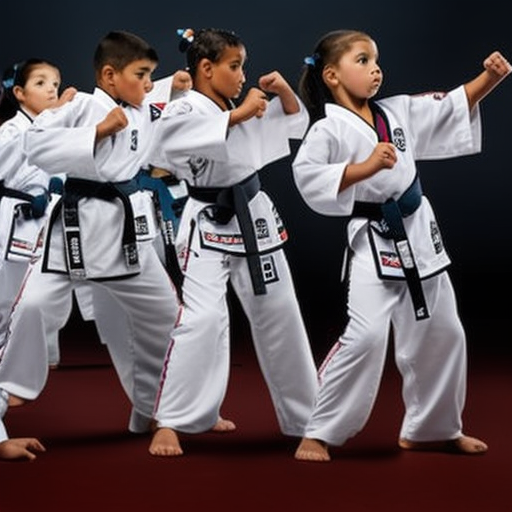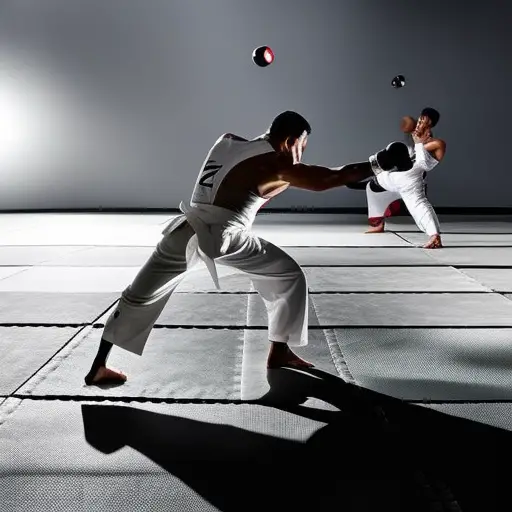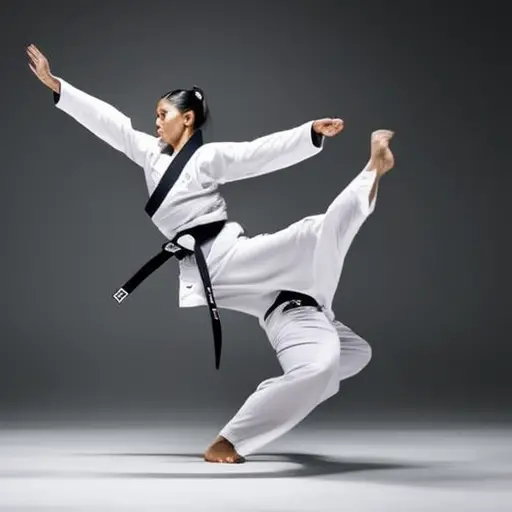The Importance of Breath Control in Taekwondo

Discover the hidden power within each breath as we delve into the intricate world of Taekwondo.
In this article, we explore the profound significance of breath control and its impact on the art of Taekwondo. By harnessing the ancient techniques of controlled respiration, practitioners can unlock a deeper level of focus, strength, endurance, and technique execution.
Join us as we uncover the secrets behind breath control and its role in elevating overall performance in the realm of Taekwondo.
The Role of Breath Control in Taekwondo Performance
During taekwondo performances, breath control plays a pivotal role in enhancing overall technique and maximizing physical endurance. In the practice of taekwondo, breath control is not only important for physical exertion but also for mental focus and concentration. One of the key aspects of breath control in taekwondo is its role in meditation.
By focusing on deep and controlled breathing, practitioners are able to calm their minds and enter a state of heightened awareness. This allows them to connect with their bodies and perform with greater precision and control.
In addition to its role in meditation, breath control also offers numerous benefits in taekwondo sparring. By regulating their breath, practitioners are able to maintain a steady flow of oxygen to their muscles, delaying the onset of fatigue. This not only improves physical endurance but also enables them to execute techniques with greater power and speed. Moreover, controlled breathing helps to calm the mind and reduce stress, allowing practitioners to make clear and calculated decisions in the heat of combat.
In summary, breath control is an essential component of taekwondo performance. Its role in meditation promotes mental focus and heightened awareness, while its benefits in sparring enhance physical endurance and technique. By mastering breath control, taekwondo practitioners can elevate their performance to new heights.
Now let’s explore how breath control enhances focus in taekwondo training.
How Breath Control Enhances Focus in Taekwondo Training
Breath control is a fundamental aspect of Taekwondo training that plays a crucial role in enhancing focus and concentration. By incorporating specific breathing techniques, practitioners are able to optimize their mental state and improve their performance.
Breath control benefits Taekwondo practitioners in several ways. Firstly, it helps regulate the body’s oxygen intake and carbon dioxide release, ensuring efficient energy utilization during training. This enables athletes to sustain their physical exertion for longer periods without feeling fatigued, thus enhancing their overall endurance and stamina.
Moreover, conscious breathing techniques promote relaxation and calmness, enabling practitioners to remain focused and composed in stressful situations. By controlling their breath, athletes can manage their emotions and prevent anxiety or panic from affecting their performance. This heightened focus allows them to analyze their opponents’ movements more accurately and react swiftly, giving them a competitive edge in combat.
Furthermore, breath control enhances the mind-body connection, enabling practitioners to synchronize their movements with their breath. This synchronization promotes a flow state, where athletes become fully immersed in their training, resulting in improved coordination, timing, and precision.
Breath Control Techniques for Improved Strength in Taekwondo
The utilization of specific breath control techniques is crucial for Taekwondo practitioners to enhance their strength and power. In addition to improving focus and concentration, proper breath control techniques can also contribute to increased strength in Taekwondo.
Here are some breath control techniques that can help practitioners improve their strength and power:
-
Diaphragmatic Breathing: This technique involves breathing deeply into the diaphragm, allowing for maximum oxygen intake and improved relaxation. By practicing diaphragmatic breathing, Taekwondo practitioners can increase their lung capacity and improve their overall strength.
-
Breath Control for Relaxation: By learning to control their breath, Taekwondo practitioners can achieve a state of relaxation and reduce tension in their muscles. This relaxed state allows for better utilization of strength and power during training and competitions.
-
Breath Control for Mental Clarity: Proper breath control techniques can also help in achieving mental clarity. By focusing on their breath, Taekwondo practitioners can quiet their minds, enhance their concentration, and make more effective use of their strength and power.
By incorporating these breath control techniques into their training, Taekwondo practitioners can improve their overall strength and power.
Now, let’s explore how proper breath control can enhance endurance in Taekwondo.
Enhancing Endurance Through Proper Breath Control in Taekwondo
Proper breath control is essential for enhancing endurance in Taekwondo.
The connection between breath and stamina is crucial in maintaining energy levels during intense training and competitions.
Breath and Stamina Connection
An effective way to enhance endurance in Taekwondo is by implementing specific breath control techniques. The connection between breath and stamina is crucial in martial arts, as proper breathing techniques can help athletes improve their endurance and overall performance. By mastering breath control, Taekwondo practitioners can experience a range of benefits, including increased mental clarity and reduced stress levels.
Incorporating breath control techniques into training sessions can have a profound impact on an athlete’s stamina. Here are three ways in which breath control enhances endurance in Taekwondo:
-
Improved oxygen intake: Proper breathing techniques allow for better oxygen intake during physical exertion, resulting in increased stamina and endurance.
-
Efficient energy utilization: By controlling their breath, athletes can optimize their energy usage, allowing them to sustain their performance for longer periods.
-
Enhanced focus and concentration: Breath control techniques promote mental clarity and reduce stress, enabling athletes to stay focused on their movements and maintain stamina throughout their training sessions.
Techniques for Controlled Breathing
Taekwondo practitioners can enhance their endurance through the implementation of controlled breathing techniques. Breathing exercises and mindfulness techniques play a vital role in achieving optimal performance in this martial art. By focusing on their breath and controlling it during training and competition, practitioners can improve their stamina and overall physical performance.
One effective breathing exercise is deep diaphragmatic breathing, also known as belly breathing. This technique involves inhaling deeply through the nose, allowing the belly to expand, and exhaling slowly through the mouth. By engaging the diaphragm, this exercise maximizes the amount of oxygen intake and helps regulate the body’s energy levels.
Mindfulness techniques, such as meditation and visualization, can also enhance breath control. Practitioners can learn to be fully present in the moment, allowing them to synchronize their breath with their movements and maintain a calm and focused state of mind. This not only improves endurance but also increases mental resilience and reduces stress levels.
Incorporating these breathing exercises and mindfulness techniques into regular training sessions can significantly enhance endurance in Taekwondo practitioners. By mastering breath control, athletes can optimize their performance and achieve their full potential in this demanding martial art.
The Connection Between Breath Control and Technique Execution in Taekwondo
Proper breath control in Taekwondo is not only crucial for enhancing endurance, but it also plays a significant role in the execution of techniques. Breath serves as the power source behind each movement, providing the necessary energy and strength.
Moreover, by focusing on controlling their breath, practitioners can improve their concentration and precision, enabling them to execute techniques with greater accuracy and effectiveness.
Breath as Power Source
The correlation between breath control and the precise execution of techniques in Taekwondo is a fundamental aspect of harnessing the power source within the practitioner. Breath control benefits are numerous, as it allows for greater stability, control, and power generation in every movement. By incorporating breath control exercises into their training regimen, Taekwondo practitioners can enhance their understanding of how to utilize their breath as a power source.
Deep diaphragmatic breathing can create a strong foundation for executing powerful kicks and strikes.
Controlled exhalation during techniques can maximize the transfer of energy and force.
Timing the breath with the execution of movements can improve accuracy and coordination.
Mastering breath control not only enhances physical performance but also cultivates mental focus and concentration. By connecting the breath with each technique, practitioners can enhance their focus, paving the way for improved overall performance in Taekwondo.
Enhancing Focus Through Breath
An effective way to enhance focus in Taekwondo is by establishing a strong connection between breath control and the execution of techniques. Breath control plays a crucial role in achieving optimal performance in any martial art, including Taekwondo. By incorporating specific breathing exercises into their training regimen, practitioners can reap numerous benefits. These include increased concentration, improved balance, and enhanced power generation.
To better understand the connection between breath control and technique execution, let’s take a look at the following table:
| Breath Control Benefits | Breathing Exercises | Technique Execution |
|---|---|---|
| Increased concentration | Diaphragmatic breathing | Improved focus and precision |
| Improved balance | Box breathing | Enhanced stability and control |
| Enhanced power generation | Kapalabhati breathing | Greater strength and explosive force |
Harnessing the Power of Breath Control in Taekwondo Strikes
Breath control plays a crucial role in maximizing the power and effectiveness of Taekwondo strikes. By harnessing breath control, practitioners are able to generate more force and deliver stronger blows. Here are three ways in which breath control can enhance striking power:
-
Increased stability: Proper breath control helps stabilize the body during strikes. By exhaling sharply at the moment of impact, the practitioner engages their core muscles, creating a solid foundation and transferring the generated power through their entire body. This stability allows for a more powerful and accurate strike.
-
Improved focus and timing: Breath control is intimately linked with concentration and focus. By regulating their breath, practitioners can calm their minds, block out distractions, and maintain a heightened state of awareness. This enhanced focus enables them to time their strikes with precision, maximizing the impact and effectiveness of each technique.
-
Enhanced speed and agility: Effective breath control allows practitioners to maintain a steady rhythm and flow in their movements. By synchronizing their breath with their strikes, they can generate explosive power and achieve greater speed and agility. This fluidity enables them to execute complex combinations with ease and deliver rapid, powerful strikes.
Breath Control as a Key to Overall Performance Improvement in Taekwondo
By effectively utilizing breath control, practitioners can significantly enhance their overall performance in Taekwondo. Breath control is not only crucial for executing powerful strikes, but it also plays a vital role in mental clarity and stress management.
In Taekwondo, mental focus and clarity are essential for success. By regulating their breath, practitioners can achieve a state of mental calmness and clarity, allowing them to make split-second decisions and react quickly to their opponent’s movements. By taking deep breaths and exhaling slowly, practitioners can lower their heart rate and activate the parasympathetic nervous system, which promotes relaxation and concentration. This mental clarity can make a significant difference in the execution of techniques, enabling practitioners to perform with precision and efficiency.
Furthermore, breath control is a powerful tool for managing stress during training and competition. Taekwondo can be physically and mentally demanding, and stress can negatively impact performance. By focusing on their breath, practitioners can regulate their stress response and maintain a calm and composed mindset. Deep breathing exercises can lower cortisol levels, which is the hormone responsible for stress, and promote the release of endorphins, which are natural mood boosters. This allows practitioners to stay focused, confident, and perform at their best even under pressure.
Frequently Asked Questions
What Are the Different Breathing Techniques Used in Taekwondo?
Breathing exercises in Taekwondo involve techniques such as deep belly breathing, diaphragmatic breathing, and breath control. These exercises help enhance focus, improve stamina, release tension, and promote relaxation, ultimately enhancing overall performance in the martial art.
How Does Proper Breath Control Help in Reducing Fatigue During Training?
Proper breath control in training reduces fatigue by improving oxygen intake, promoting relaxation, and enhancing focus. Like a meditative practice, deep breathing techniques enhance endurance, allowing practitioners to perform at their best.
Can Breath Control Improve Flexibility and Balance in Taekwondo?
Breath control plays a significant role in improving flexibility and balance in Taekwondo. By enhancing focus and concentration, it allows practitioners to execute precise movements. Additionally, it helps in controlling adrenaline levels, leading to better control and stability during training.
What Are Some Tips for Beginners to Improve Their Breath Control in Taekwondo?
To improve breath control in Taekwondo, beginners can start by practicing breathing exercises, such as diaphragmatic breathing. It is also important to be aware of common mistakes in breath control, such as shallow breathing or holding one’s breath.
Is There a Specific Breathing Pattern That Should Be Followed During Different Taekwondo Techniques?
Breathing techniques during sparring in Taekwondo are crucial for optimal performance. Different techniques may require specific breathing patterns to ensure proper execution and maximize power. Incorporating breathing exercises can enhance breath control and overall skill proficiency.
Conclusion
In conclusion, breath control plays a vital role in enhancing performance and overall improvement in Taekwondo. It not only helps in maintaining focus and enhancing strength, but also improves endurance and technique execution.
By harnessing the power of breath control, practitioners can achieve greater precision and effectiveness in their strikes, ultimately leading to a deeper connection with their practice.
Just as the breath flows seamlessly, so too can the practitioner’s movements, creating a harmonious and powerful expression of Taekwondo.





